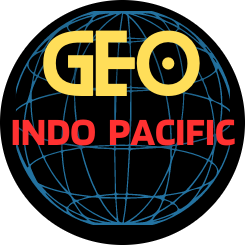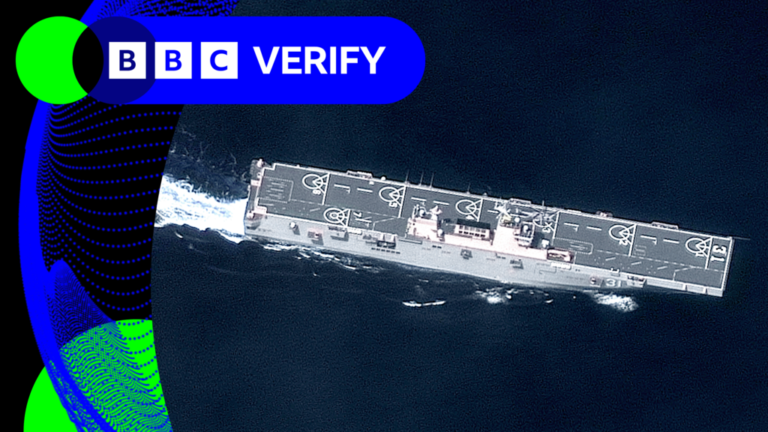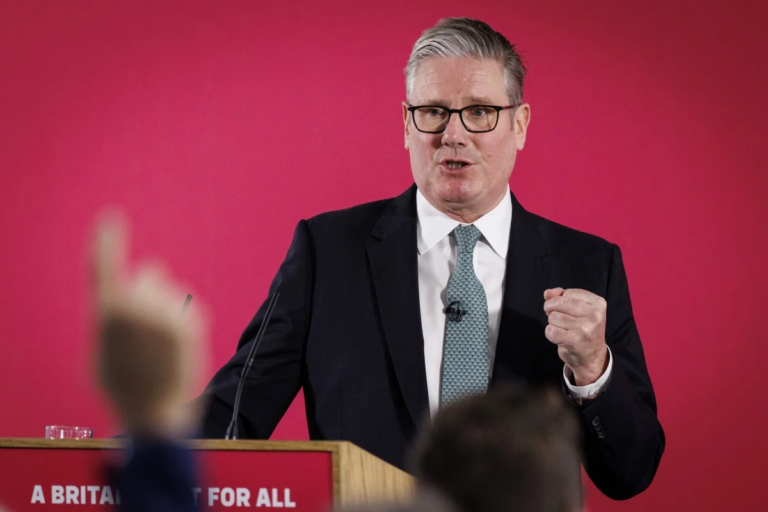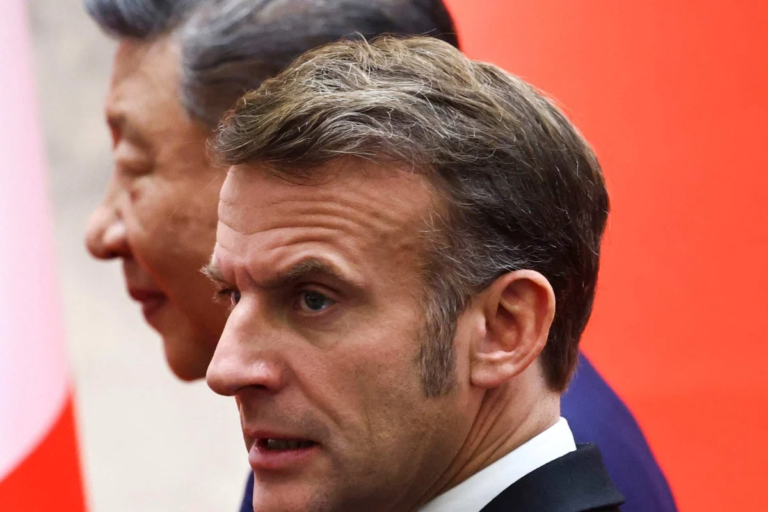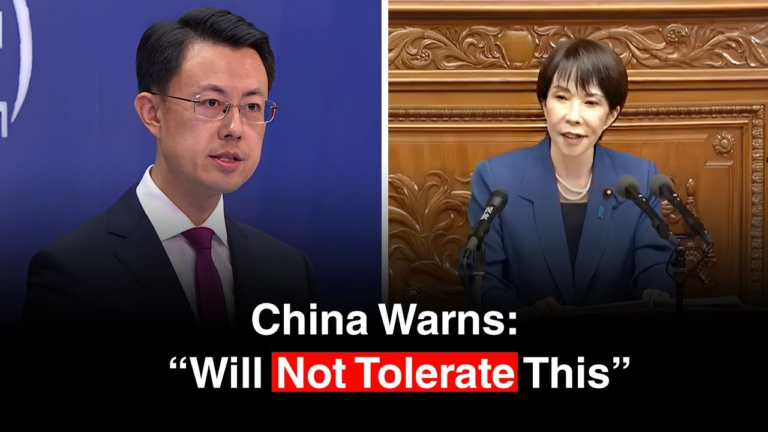
Toplines
The United States and the PRC are finalizing an agreement on the sale of TikTok to US investors. The deal would reportedly allow PRC-based company ByteDance to retain ownership of the proprietary TikTok content algorithm, which would mark a major US concession to Beijing.[1] This would allow ByteDance to retain control over the content that TikTok promotes to its users. The CCP could easily co-opt the algorithm to spread disinformation and shape public opinion to its advantage, especially during military operations against Taiwan.[2] The Taiwan Information Environment Research Center found that TikTok users in Taiwan were considerably more likely to view the PRC positively and agree with CCP-aligned narratives regarding Taiwan and its relations with the United States compared with non-users.[3]
The TikTok deal would come after the United States gave other concessions to the PRC to facilitate negotiations. Western media have reported in recent weeks that the United States denied Taiwanese President Lai Ching-te permission to visit and lifted restrictions on certain technology exports to the PRC—both meant to reduce tension with the PRC.[4]
The PRC is evolving its efforts to erode Taiwan’s sovereignty around its outlying islands, possibly including Penghu. The PRC launched those efforts around the islands of Kinmen and Pratas in May 2024 and February 2025, respectively. The China Coast Guard (CCG) has repeatedly deployed to the Taiwanese-administered waters around Kinmen and Pratas ostensibly to protect PRC fishing vessels from Taiwanese authorities. This PRC effort is meant to test and exhaust Taiwanese response elements, intimidate Taiwanese leaders and the public, and portray the PRC as the legitimate authority over the islands by normalizing operations there.
The PRC intensified its maritime incursions into Taiwanese-administered waters in recent days. The CCG and several PRC fishing vessels entered or tried to enter the restricted waters around Pratas from September 11 to 15.[5] Data from the Starboard Maritime Intelligence shows that additional ostensibly civilian PRC vessels operated there from September 15 to 17. The CCG separately conducted four incursions around Kinmen from September 15 to 17.[6] This CCG activity is the highest frequency of consecutive incursions around Kinmen that CDOT-ISW has observed to date, likely representing all of the planned incursions for September, but very closely clustered together. The CCG normalized a pattern of four Kinmen incursions per month since 2024 but has varied the timing, entry points, and tactics of these incursions as a means of testing Taiwan’s response.
The PRC may be preparing to expand its efforts to erode Taiwanese sovereignty to the Penghu archipelago. A doctored video has circulated on TikTok and other online media platforms in recent days, purportedly showing a PLA Navy ship blocking Taiwan’s Coast Guard Administration (CGA) law enforcement operations against a PRC fishing vessel in the Penghu contiguous zone. The CGA debunked the video on September 14, stating that the video deceptively combined footage from two separate incidents.[7] The first incident was the CGA expelling a PRC fishing vessel from the Penghu contiguous zone, while the second was the CGA encountering a PLA Navy ship a day or two later. The PLA Navy ship did not prevent the CGA from expelling the PRC fishing vessel, as the doctored video alleged. The CGA accused the PRC of promoting the video as a cognitive operation, possibly meant to intimidate Taiwanese leaders and the public as well as normalize the PLA Navy operating near the Penghu islands.[8] The Penghu islands are entirely inside Taiwanese territorial waters and would be strategically significant in any PRC attack on Taiwan given the proximity of the archipelago to the Taiwanese main island.[9] The US Taiwan Relations Act, the basis for the unofficial relations between the United States and Taiwan, includes the Penghu Islands in its definition of “Taiwan” but does not mention other outlying islands.[10]
The PRC may also be evolving its coercive activity in the airspace around Kinmen. Taiwanese media reported on September 9 that PLA fighter jets harassed a Taiwanese medical evacuation plane flying to Kinmen in June 2025.[11] PLA JH-7 and J-10 combat aircraft approached the Taiwanese plane without warning and flew within its visual range for about five minutes.[12] Aircraft flying to Kinmen must transit PRC airspace, though it is unclear exactly where this incident occurred. This PRC coercion—like the activity in the Taiwanese-administered waters—is meant to erode Taiwanese sovereignty. This incident is especially noteworthy given how normal Taiwanese medical evacuation missions to Kinmen are. Taiwan conducted 85 such missions annually from 2018 and 2024.[13] PLA harassment of civilian flights around Kinmen would mark a significant escalation against Taiwan and would be difficult to counter without sending fighter jets into PRC airspace.
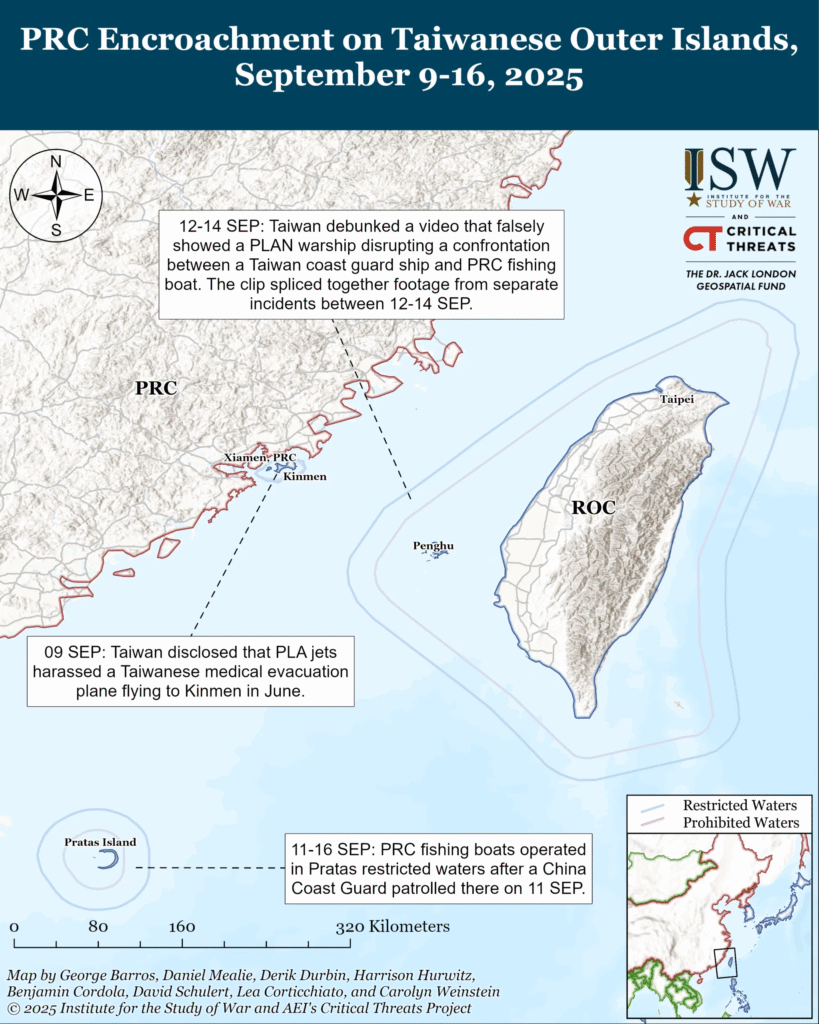
The PLA Navy conducted its first long-range transit through the Taiwan Strait with its newly constructed aircraft carrier Fujian from September 11 to 12, highlighting PRC efforts to increase its force projection capacity. Fujian left Shanghai before sailing north of the Senkaku islands and through the Taiwan Strait.[14] Fujian began sea trials in May 2024 and tested its catapult-assisted launch but arrested recovery system in May 2025, leading to media speculation that the commissioning of the ship is imminent.[15] PLAN carrier Shandong similarly transited the Taiwan Strait before commissioning in December 2019.[16]
Fujian maintains significant improvement relative to PLAN carriers Shandong and Liaoning. Fujian is the second carrier in the world to feature an electromagnetic catapult that enables faster launches of large aircraft, including the EJ-600 airborne early warning and control system that the PLA recently showcased.[17] The EJ-600 is expected to increase the survivability of Fujian due to its long-range radar, which can reportedly detect sea-skimming munitions.[18] PRC state media has celebrated the role that the EJ-600 could play in facilitating out-of-area carrier deployments.[19]
Fujian will be the third carrier that the PLA Navy has commissioned. A third carrier would enable the PLA to maintain a more consistent naval presence around the Indo-Pacific and increase the PLA ability to threaten enemy sea lines of communication.[20] The PLA conducted an exercise with its current two carriers—Shandong and Liaoning—around critical sea lines of communication between Taiwan, Japan, and Guam in June 2025.[21] Fujian would help the PLA threaten those areas while retaining naval forces needed to safeguard PRC interests elsewhere. Fujian would also help mitigate the disruption to naval operations created when some carriers are undergoing maintenance and repair. The improved power projection capacity that Fujian provides would complicate coalition efforts to come to Taiwan’s aid during a contingency as a result.[22]
The PRC announced preliminary results of an anti-monopoly probe targeting Nvidia, likely to retaliate for US export controls and gain leverage in ongoing trade negotiations with the United States. The PRC State Administration for Market Regulation ruled in a preliminary investigation that Nvidia violated antitrust regulations in its merger with Mellanox despite approving the merger when it was first announced.[23] The PRC State Council separately announced anti-dumping investigations into certain US semiconductors on September 13.[24] These announcements coincide roughly with the US-PRC trade negotiations from September 14 to 17.[25] The Financial Times reported that the Cyberspace Administration of China (CAC) had banned companies from buying Nvidia RTX Pro 6000D chips. This follows the PRC ban on H20 chips after the US relaxed export controls in July.[26] US Treasury Secretary Scott Bessent previously referred to Nvidia export controls as a “negotiating chip” for trade talks in July.[27]
The anti-dumping investigations also follow the United States adding 23 PRC companies to its entity list on September 12, targeting firms involved in semiconductors and biopharmaceuticals, among other fields. The United States has adjusted its export controls ahead of previous rounds of negotiations with the PRC.[28] Beijing has likewise tried to exploit its dominance of critical earths supply chains to extract concessions from Washington.
Cross-Strait Relations
Taiwan
The Taiwanese CGA has increased patrols around a critical undersea cable to deter PRC sabotage. The CGA is conducting 24-hour patrols around the Taiwan-Peng No. 3 Submarine Cable—one of Taiwan’s 24 domestic and international subsea internet cables.[29] Reuters reported that it became the first media outlet to join one of these patrols on August 28.[30] The CGA alarm system will detect ships approaching the cable within one kilometer at a low speed—an indicator of suspicious activity—and share suspicious ships’ location data with “like-minded” countries.[31] This is consistent with Taiwan’s previous efforts to collectively deter suspicious vessels; Taiwan signed a memorandum of understanding to acquire Canada’s dark vessel detection system in August 2025.[32]
CDOT-ISW identified cable-cutting as a way that the PRC could isolate Taiwan in a short-of-war or invasion contingency.[33] Taiwan is highly reliant on undersea internet cables, which PRC-crewed ships have damaged on multiple occasions.[34] Taiwan jailed a PRC ship captain and deported his crew after his Togolese-registered cargo ship cut the Penghu cable in February 2025.[35] Taiwanese President William Lai Ching-te has made communications and infrastructure resilience a key element of his administration’s messaging and policy.[36]
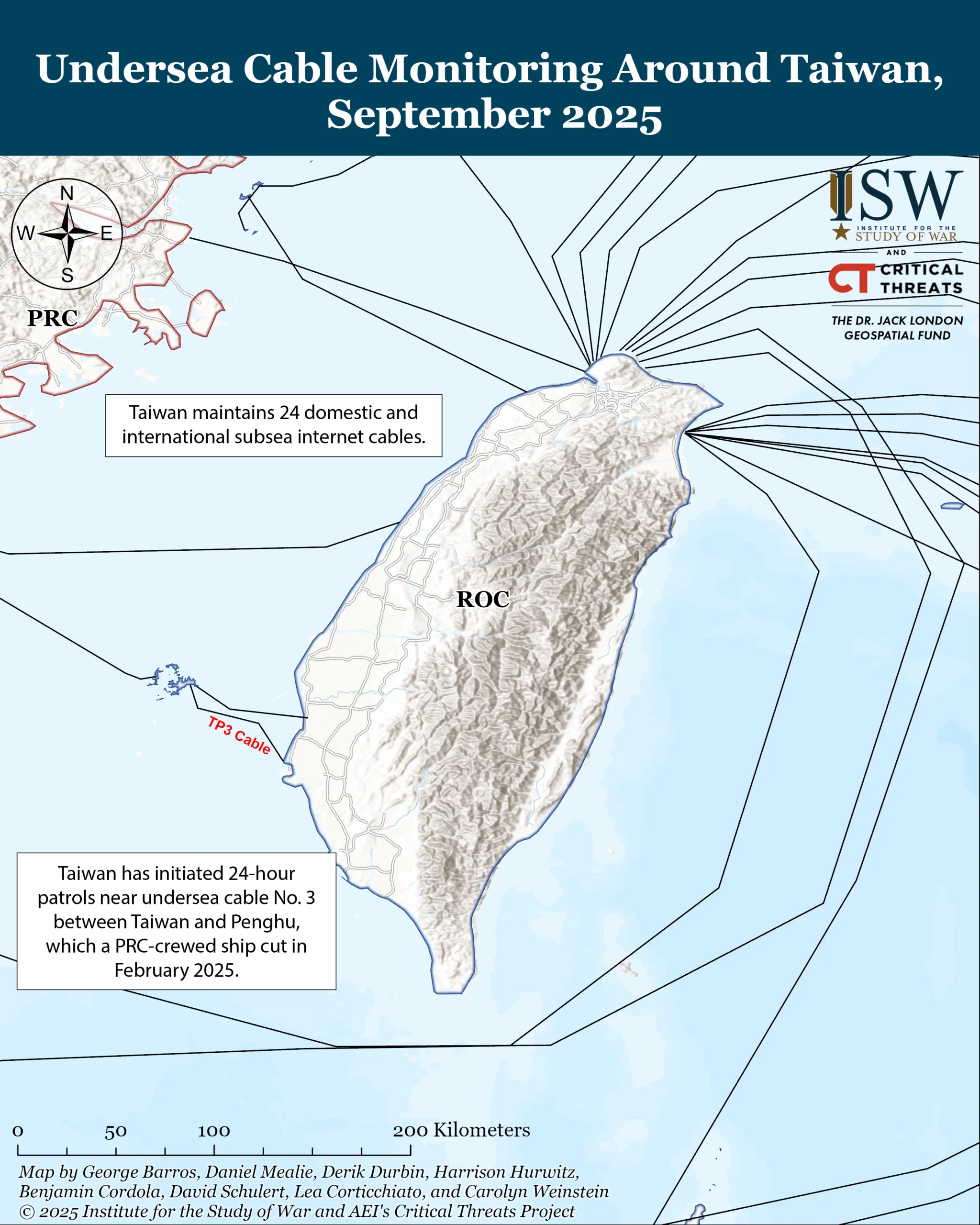
The US House of Representatives passed the 2026 National Defense Authorization Act (NDAA) on September 10, including several provisions intended to enhance Taiwanese security and US-Taiwanese military cooperation. The NDAA provides the annual budget and expenditures of the US Defense Department and contains five sections concerning Taiwan.[37] Two of the sections concern the Taiwan Security Cooperation Initiative (TSCI), most notably increasing funding from 300 million US dollars in FY 2025 to 1 billion US dollars in FY 2026.[38] The TSCI authorizes the United States to help “enable Taiwan to maintain sufficient self-defense capabilities.”[39] The 2026 NDAA also requires the Department of Defense to produce a report assessing Taiwan’s critical digital infrastructure in the event of a PLA invasion or blockade in order to identify ways that the Department of Defense can help enhance Taiwanese capabilities “consistent with the Taiwan Relations Act.”[40] The 2026 NDAA also calls for cooperation between the Department of Defense’s Defense Innovation Unit (DIU) and Taiwanese counterparts to enhance Taiwan’s defense industrial base and jointly develop emerging technology to counter PLA military developments.[41] The 2026 NDAA also strongly encourages the Secretary of Defense to invite Taiwan to the Rim of the Pacific (RIMPAC) exercises.[42]
These provisions reflect the importance of Taiwan’s defense and countering PRC aggression within United States defense priorities. The NDAA emphasizes the importance of enhanced Taiwanese production capacity through monetary assistance and joint technological development. Taiwan is similarly working to pass a special budget that would significantly increase defense spending.[43] The ruling Democratic Progressive Party (DPP) has stressed the importance of increasing Taiwan’s defense budget since President Lai entered office in May 2024. The opposition Kuomintang (KMT) passed major budget cuts, including defense budget cuts, in January.[44] The KMT controls Taiwan’s Legislative Yuan (LY) and may seek to block the special defense budget. The 2026 NDAA may provide an alternative source of defense funding for Taiwan if the defense budget is rejected, allowing Taiwan to continue developing its military capabilities with US assistance.
The PRC criticized the military transits of US and UK warships through the Taiwan Strait as “provocative.” US guided-missile destroyer USS Higgins and British anti-submarine frigate HMS Richmond transited the Taiwan Strait on September 12. This is the third US Freedom of Navigation Operation (FONOP) and second UK FONOP in 2025. Both UK FONOPs in 2025 follow the eight-month deployment of HMS Prince of Wales to the Indo-Pacific that began in April, as the UK seeks to increase its presence in the region. It is the first UK deployment to the Indo-Pacific since HMS Queen Elizabeth in 2021.[45] The PRC Eastern Theater Command (ETC) issued a standard condemnation of the transit and stated that it dispatched naval and air forces to monitor the situation.[46] The US-UK transit occurred on the same day as the PLA Navy Type 003-class aircraft carrier Fujian’s first transit through the Taiwan Strait toward the South China Sea.[47] The US-UK transit also follows a FONOP in the Taiwan Strait by Canadian Halifax-class frigate HMCS Ville de Québec and Australian Hobart-class guided-missile destroyer HMAS Brisbane on September 6.[48]
A Taiwanese investigation of military personnel and public servants found around 100 people who held PRC identity documents, which the government has warned can pose a risk to national security. Taiwan’s Mainland Affairs Council (MAC) announced that its investigation of over 627,000 individuals found two people who held PRC citizenship and 102 with PRC residence permits.[49] The MAC said that the people found with PRC ID cards or resident permits have since renounced them, and that 99.79 percent of public employees have signed the required affidavits that they do not possess PRC ID documents.[50] Taiwan will begin regular inspections on January 1, 2026, to ensure that PRC nationals or residents do not hold military or civil service jobs.[51] Taiwanese law stipulates that Taiwanese nationals who obtain a PRC household registration or a PRC passport lose their Taiwanese citizenship and are banned from serving in the military. Taiwan has cracked down on possession of PRC IDs as part of President Lai’s “17 Measures” to counter PRC infiltration.[52] The PRC has framed this effort as persecution of PRC spouses living in Taiwan, with Taiwan Affairs Office (TAO) spokesperson Chen Binhua claiming on September 10 that the Lai administration was “deliberately forcing separations in cross-strait families” and “fabricating” a nationality issue.[53]
The PRC has been trying to promote “cross-strait integration” by encouraging Taiwanese people to live, work, or study in the PRC and obtain PRC ID cards, a form of “passportization” that reinforces Beijing’s claim that Taiwanese people are PRC citizens.[54] Beijing’s efforts to infiltrate Taiwan’s government and military do not appear to rely on “dual” ID holders such as PRC immigrants to Taiwan, however. The number of PRC ID holders that Taiwan discovered among its civil servants was relatively small, and the vast majority of Taiwanese people convicted for spying for the CCP were not known to hold PRC citizenship or residency.
China
The PRC purged four generals and ended partnerships with over 200 suppliers for the PLA Rocket Force (PLARF) as part of its ongoing campaign to address corruption related to missile procurement. The Standing Committee of the PRC National People’s Congress (NPC) said on September 12 that it had removed four generals as deputies to the NPC.[55] The expelled delegates are General Wang Chunning, commander of the People’s Armed Police (PAP); Lieutenant General Wang Zhibin, Secretary of the Commission for Discipline Inspection of the PLARF; Lieutenant General Zhang Lin, head of the Central Military Commission’s (CMC) Logistics Support Department; and Vice Admiral Gao Daguang, political commissar for the PLA Joint Logistics Support Force. Removal from the NPC may pave the way for harsher punishments, including criminal prosecution, as NPC delegates enjoy special legal protections.[56] The NPC did not specify the reason for their removal, and CCP authorities have not announced that the generals were relieved of their military posts.
The removal of Wang Zhibin, Zhang Lin, and Gao Daguang may be related to the discovery of widespread corruption in the PLARF and military procurements departments in 2023, which appeared to seriously undermine CCP confidence in the efficacy of the PLARF.[57] The CCP has fired a number of high-level PLA commanders, including former PLARF Commander Li Yuchao, former Defense Minister Li Shangfu, and former Defense Minister Wei Fenghe. All three were expelled from the CCP, and the two former defense ministers face criminal prosecution charges likely due to corrupt equipment procurement.[58] Lieutenant General Wang Zhibin was appointed to lead the PLARF’s disciplinary body after the wave of corruption investigations in 2023.[59] His removal from the NPC suggests that CCP General Secretary Xi Jinping is displeased with the efforts to rid the PLARF of corruption. The removal of two top officials in military logistics may be connected to the same anti-corruption effort. PAP Commander Wang Chunning’s removal likely is not connected to missile procurement and instead may be due to unrelated corruption or political disloyalty. Wang Chunning reportedly missed key meetings beginning in December 2024, not long after the CMC suspended its top political commissar Miao Hua.[60]
The PLARF also ended partnerships with nearly 200 suppliers and experts between August 28 and September 1, following an investigation into PLARF procurement corruption over the past nine years.[61] The official China Government Procurement News reported that the PLARF banned 74 bid evaluation experts and 116 suppliers and marked them as unqualified to work on military projects. The announcement said that most of the experts were punished for “evaluation errors,” but some were fired for corrupt bidding practices. Most of the banned suppliers, including state-owned enterprises, were accused of rigging bids or submitting false materials. The PLARF’s termination of these partnerships shows that the CCP continues to have concerns about corruption jeopardizing the procurement of essential military equipment.
Northeast Asia
Japan
The PRC issued stern warnings to Japan over former Taiwanese President Tsai Ing-wen’s visit, reflecting PRC double standards toward former DPP officials. Tsai visited Japan on September 9, marking her first visit since leaving office in May 2024. Tsai’s office declined to comment on her itinerary, claiming that it was a private visit and that she did not meet with any Japanese officials.[62] PRC Ministry of Foreign Affairs spokesperson Lin Jian reiterated the PRC’s firm opposition to the “illegitimate visits” made by “Taiwan independence separatists” to countries that have formal diplomatic relations with the PRC.[63] Lin further stated that, regardless of the pretext of Tsai’s trip, as the “former leader of the Taiwan region,” Tsai cannot hide the fact that her trip was to “seek foreign support for Taiwan independence.”[64]
The PRC often protests visits to foreign countries made by senior Taiwanese officials from the DPP.[65] The PRC typically is less critical of visits made by officials of the opposition KMT, however. Former Taiwanese President and KMT figurehead Ma Ying-jeou has made at least six visits to the United States, during which he gave public talks, since he left office in May 2016.[66] The PRC did not issue any official protests or condemnations following Ma’s visits. The PRC also did not comment on Ma’s visit to Harvard University in 2015 while he was still the sitting president.[67]
The PRC’s divergent responses to visits by Tsai and Ma underscore how the PRC views the KMT as its preferred counterpart in Taiwanese politics and delegitimize the DPP.[68] The PRC’s double standards are likely part of its efforts to pressure other countries to avoid engagements with DPP officials, and reinforce PRC narratives that the DPP will “provoke” a cross-Strait conflict.[69]
North Korea
Workers’ Party of Korea (WPK) General Secretary Kim Jong Un announced that the 9th Party Congress in 2026 will propose a defense policy focused on the “parallel development of nuclear and conventional military capabilities,” marking a shift from previous policies focused solely on nuclear capabilities.[70] North Korea holds the WPK Party Congress every five years.[71] The 8th Party Congress in 2021 focused on strengthening and diversifying nuclear capabilities, including manufacturing super-large nuclear warheads and developing submarine- and ground-launched intercontinental ballistic missiles (ICBMs) using solid-fuel engines.[72]
North Korea’s new defense policy announcement precedes the expected military parade on October 10, marking the 80th founding anniversary of the WPK. The event will likely highlight the regime’s five-year progress in nuclear weapons development, likely portraying Kim as a defender against threats from the United States and its allies and rallying national unity. This narrative sets the tone for the new defense development plan. The shift in policy could indicate that North Korea has recognized the need to modernize its conventional capabilities, which it has previously neglected. This new defense concept could stem from North Korea’s experience in Russia, where its deficiencies in modern conventional capabilities became more apparent. Kim made the announcement after touring the Defense Science Academy’s Armored Weapons Research Institute on September 11, overseeing tests to enhance the tank’s defenses against anti-tank missiles.[73] North Korea likely observed the importance of tank defensive capabilities while fighting in Russia, which could have resulted in the increased domestic focus on these technologies.
North Korea denounced the combined United States, South Korean, and Japanese Freedom Edge exercise and emphasized its status as a nuclear-armed state was “irreversible” on September 13.[74] WPK Central Committee Vice Department Director Kim Yo Jong stated on September 15 that North Korea regards the Freedom Edge exercise as “confrontational.”[75] WPK Central Military Commission Vice Chairman Park Jung Chun also stated that Freedom Edge is the “most aggressive rehearsal for an invasion” of North Korea on September 15.[76] Park accused the United States and its allies of “destroying the security environment” of the Korean peninsula and demanded North Korea increase its deterrence capabilities.[77] The United States, South Korea, and Japan are conducting the combined exercise from September 15 to 19 off the coast of Jeju Island, aiming to improve the three countries’ interoperability against “shared threats” in the Indo-Pacific.[78]
North Korean rhetoric seeks to portray its nuclear development as a defensive measure against the United States and its allies. It simultaneously rejects diplomatic overtures from South Korean President Lee Jae Myung, whose administration has implemented policies aimed at reducing military and economic tensions with North Korea.[79] North Korea’s statements equating the Lee administration with the previous Yoon government indicate its intention to continue distancing itself from engagement with South Korea despite the change in leadership. North Korea continues to demand that the United States and South Korea halt their exercises and abandon denuclearization efforts on the Korean peninsula, seemingly expecting political and economic concessions without committing to denuclearization.
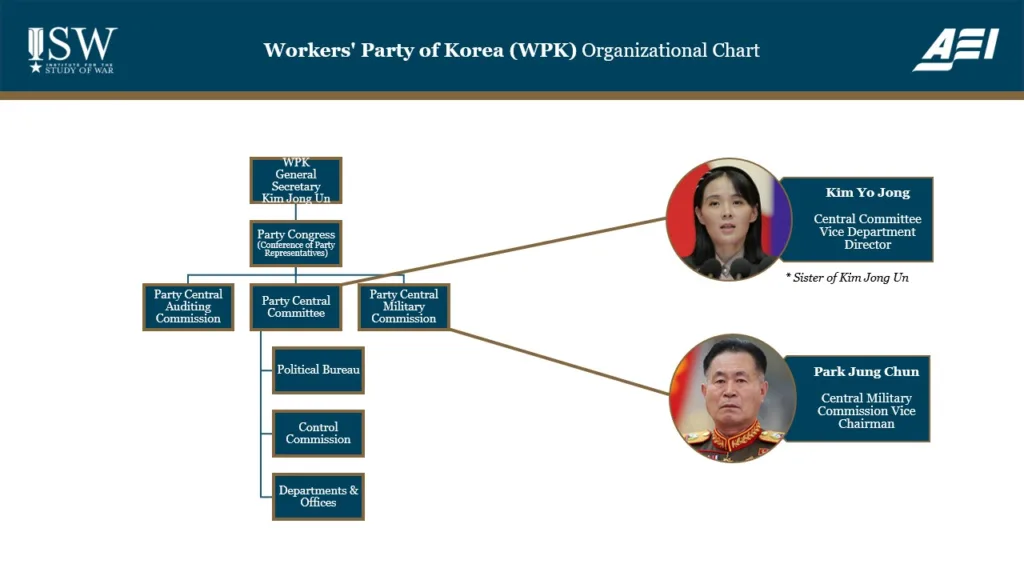
South Korea
South Korean Foreign Minister Cho Hyun met with PRC Foreign Minister Wang Yi in Beijing on September 17. The PRC did not reaffirm its commitment to denuclearization on the Korean peninsula despite South Korea’s urging.[80] Cho delivered South Korea’s call for the PRC to play a “constructive” role in implementing denuclearization on the Korean peninsula.[81] Wang responded that the PRC continues to seek “stability and peace” on the Korean peninsula. Cho said that the PRC did not raise the issue related to anti-PRC protests in South Korea but emphasized the importance of people-to-people exchanges from both countries.[82] Cho instead explained to the PRC that protests are unavoidable in a democratic country but that the government is making efforts to ensure they do not “cross the line.”[83]
The PRC’s ambiguous position on denuclearization marks a notable shift in its longstanding opposition to North Korea’s nuclear development program since 2006.[84] The PRC abstained from voting on a United Nations resolution to renew a panel of experts that monitors North Korea’s sanctions violations in 2024.[85] Xi held a summit with Kim Jong Un on September 3 readout for which made no mention of denuclearization.[86] Wang did not clarify the PRC’s stance on North Korea’s denuclearization during his meeting with Cho, though he confirmed that the PRC’s position on maintaining peace and stability in the region remains unchanged.
The PRC reportedly deployed its Type 054A and 054B frigates to the bilateral Provisional Measures Zone (PMZ) in the Yellow Sea at least three times daily from August 23 to 28, coinciding with South Korean President Lee Jae Myung’s visits to Japan and the United States for summit talks.[87] South Korea and the PRC established the PMZ on August 3, 2000, in overlapping areas of their exclusive economic zones (EEZs) to manage disputes over fishing and resource exploration.[88] The PRC reportedly began constructing fish-farming structures in the PMZ in December 2024, as former South Korean President Yoon Suk-yeol declared martial law, leading to his impeachment in April 2025. The PRC continued installations amid a leadership vacuum in Seoul, and tensions escalated in February 2025 when the CCG blocked a South Korean research vessel from inspecting the structures.[89] The PRC declared multiple temporary no-sail zones in the PMZ to conduct naval exercises involving the Fujian in May 2025.[90] The recent frigate deployment marks the PRC’s first in the disputed waters since the Lee administration began.
The PRC likely deploys naval assets to assert territorial control over the Yellow Sea, to normalize maritime encroachment and lower the threshold for South Korean response. PRC encroachment surged during a period of political turmoil in South Korea, likely capitalizing on South Korea’s limited ability to resist PRC activities.[91] South Korea’s attempt on February 26 to inspect the PRC installations within the PMZ failed following a blockade from the PRC. The Lee administration may be reluctant to risk escalating tensions amid its efforts to improve diplomatic ties with the PRC, which could lead the PRC to further restrict South Korea’s use of waters around the PMZ. The PRC has used similar means to assert territorial control in the South China Sea, building island bases that it eventually militarized.[92]

Southeast Asia
Philippines
The PRC and the Philippines accused each other of deliberately ramming into the other’s vessels around Scarborough Shoal on September 16. Both the Philippines and PRC conducted a second round of second naval exercises this month. Philippine Coast Guard (PCG) spokesperson Jay Tarriela stated that two CCG vessels targeted the BRP Datu Gumbay Piang fishing vessel near Scarborough Shoal, and attacked with water cannons, damaging the ship and injuring a crew member.[93] CCG spokesperson Gan Yu claimed that the Philippines intruded into PRC waters with over 10 government vessels, with one vessel deliberately ramming into a CCG vessel.[94] The confrontation comes five days after the PRC announced plans to establish a “nature reserve” around Scarborough Shoal, which the PRC claims despite the shoal falling within the Philippine EEZ.[95] Philippine spokesperson for the West Philippine Sea (WPS) Rear Admiral Roy Vincent Trinidad rejected the PRC’s attempts to form a nature reserve around Scarborough Shoal and stating that the Philippines will not cede “one square inch” of its sovereign territory.[96]
Both the Philippines and PRC conducted naval exercises in the South China Sea this past week. The Philippines, Japan, and the United States conducted their second Maritime Cooperative Activity (MCA) this month from September 11 to 13.[97] This was the 11th iteration of the MCA and included anti-submarine warfare exercises, search and rescue exercises, and cross-deck landing exercises. The PLAN also conducted its second “routine patrol” this month from September 12 to 13 in the South China Sea.[98] PLA Southern Theater Command spokesperson Tian Junli referred to the combined patrols led by the Philippines in the South China Sea as “collusion,” and issued a warning to the Philippines.[99] The Philippines, Australia, and Canada participated in the previous MCA around Scarborough Shoal from September 2 to 3, and the PLAN patrolled on September 3 in response to that MCA.[100]

Oceania
The Pacific Islands Forum (PIF) concluded and resolved to maintain Taiwan’s status as a PIF “development partner.” Ongoing disputes over Taiwan’s status in the PIF reflect Oceania’s efforts to balance between the PRC and other regional partners. The 2025 forum excluded the PRC, the United States, Taiwan, and other partners, possibly to minimize controversy over Taiwan’s status.[101] The forum ended on September 12 and ended with a closed-door meeting on the status of partner nations.[102] PIF leaders released a joint statement emphasizing that the forum would maintain its 1992 resolution on “development partner” nation status.[103] The 1992 agreement allowed Taiwan to participate in PIF programming since 1993.[104] Taiwan’s Ministry of Foreign Affairs (MOFA) thanked the PIF for its decision, stating that “Taiwan will continue to uphold the spirit of diversity and inclusiveness of the ‘Pacific Way.’”[105] Three Pacific countries (Palau, the Marshall Islands, and Tuvalu) recognize Taiwan despite PRC efforts to erode Taiwan’s diplomatic recognition in the region.[106]
The PRC deployed its “Fengqiao experience” (枫桥经验) system in the Solomon Islands, reflecting the Solomons’ role as a testing ground for PRC security policy. The Fengqiao system originated during the Cultural Revolution as a means of local policing used to uncover “class enemies.” Xi Jinping revived the concept in PRC political discourse in 2013, reflecting Xi’s emphasis on ideological unity.[107] PRC police have reportedly visited multiple Solomon Islands villages to promote the Fengqiao model, including by introducing surveillance drones.[108] The Fengqiao model will involve “community policing work, population management, trained skills, such as filling out household registration cards and population information cards, drawing community maps, and collecting fingerprints and palm prints.”[109] PRC police reportedly promoted the Fengqiao model while visiting sixteen villages in the province of Malaita, which has experienced anti-PRC protests.[110]
The Solomon Islands and PRC maintain close economic and security ties, with the PRC comprising the Solomon Islands’ largest export market and its third-largest aid donor as of 2022.[111] The PRC and Solomon Islands reached a bilateral security deal in 2022, prompting concerns that the PRC could station forces or a military base there.[112] The Solomon Islands are located at the nexus of the South Pacific, Coral Sea, and Solomon Sea ocean routes, giving the location strategic value.[113] The PRC in 2022 dispatched the PRC Public Security Bureau’s Solomon Islands Policing Advisory Group to the islands to train local security forces following anti-government riots.[114] PRC efforts to implement the Fengqiao experience in the Solomon Islands could reveal an intent to implement it elsewhere. CDOT-ISW previously assessed that the Fengqiao concept may be the CCP’s framework for ensuring a backup form of internet control.[115]
Australia and Papua New Guinea (PNG) agreed to a new defense pact to support coalition-building efforts against the PRC. The two countries signed a communique on the pact but have not finalized signing the treaty at the time of writing.[116] The agreement will allow Papuans to serve in Australia’s military and vice versa; previously, Australia had only accepted enlistments from Five Eyes partner nations (New Zealand, Canada, the United States, and Britain).[117] Australia reported on September 17 that the agreement will include a mutual defense pact and “will be signed following Cabinet processes in both countries.”[118] ABC Australia reported that the treaty also stipulates that Australia and PNG will hold annual combined Pukpuk exercises and will collaborate on “electromagnetic warfare and cyberspace.”[119]
The agreement follows Australia’s Talisman Sabre exercises, which incorporated PNG for the first time in 2025 in its most comprehensive iteration to date. It also follows Vanuatu’s delay of a planned security agreement with Australia over concerns the former would lose access to foreign financing, likely from the PRC.[120] Australia’s security deals reflect its efforts to coalition-build and deepen ties in the Pacific amid growing PRC foreign influence in both New Zealand and Australia. Australia has provided the most development finance to Pacific nations overall, followed by the Asian Development Bank and thirdly the PRC.[121]
